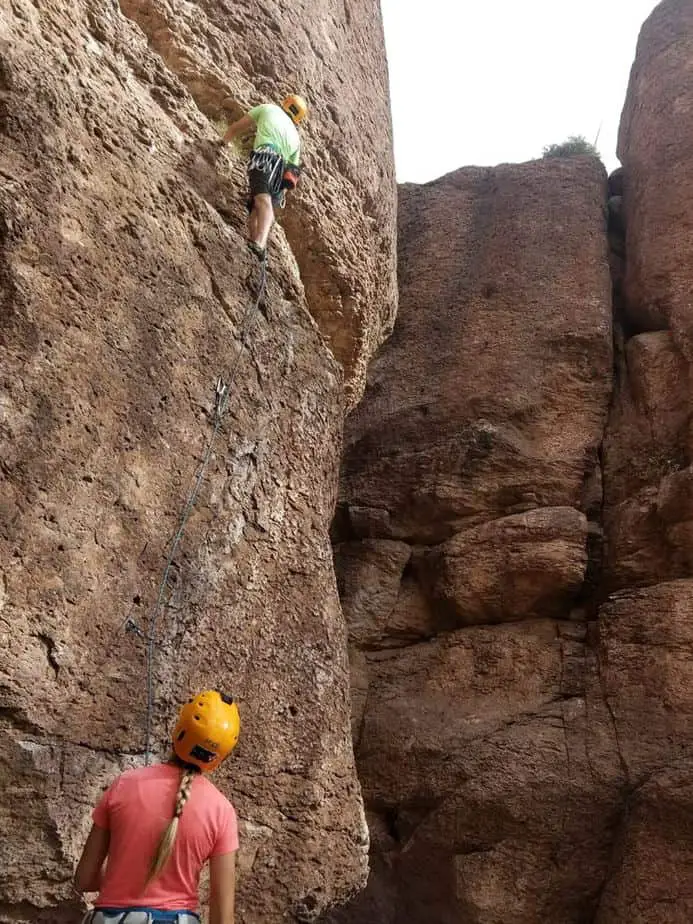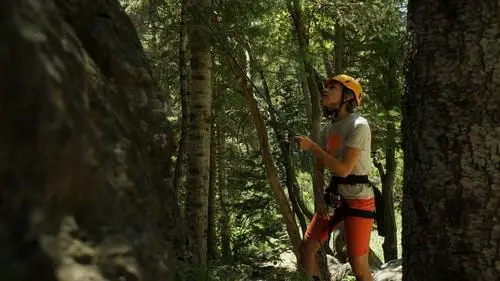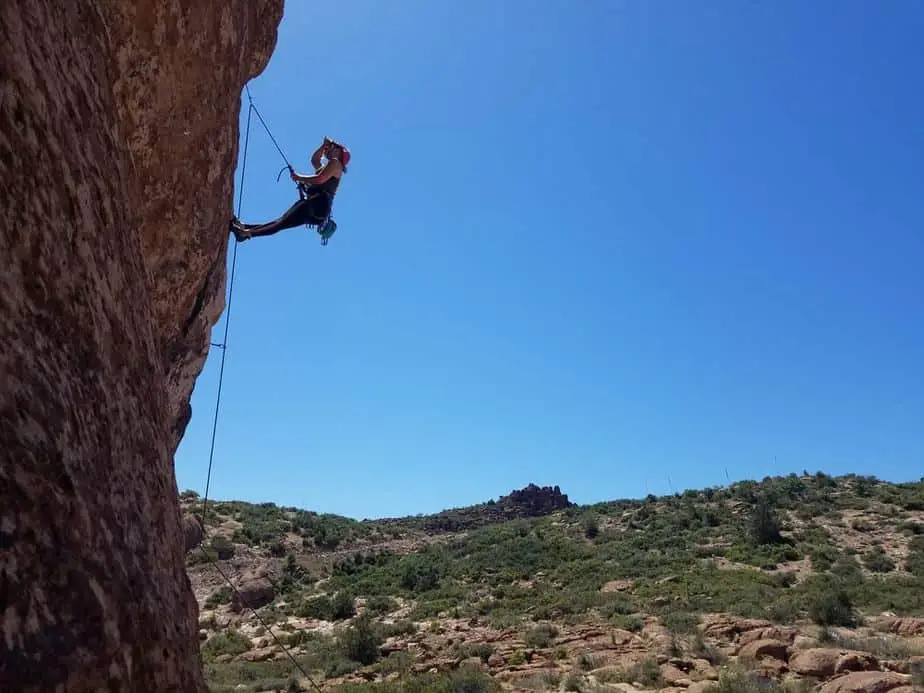If there’s one thing between you and lead climbing, it’s probably the fear and uncertainty of falling. Climbing on top rope, whether in the gym or outside, means that you only fall the amount that the rope stretches. With lead climbing however, it can be very different.
With lead climbing, a climber falls twice the distance they are above the last bolt or piece of protection, plus the distance the belayer moves and the rope stretch factor. This is normally about 10 feet (3m), but can be a lot longer in some circumstances.
Falling is scary, and it should be scary! At the same time, it’s part of the reason for the allure of rock climbing- it’s kind of like a roller coaster at an amusement park. It’s exhilarating, as long as you stay safe. What follows is everything you need to know about falling, and how you can do so safely.
How Far Do You Fall Lead Climbing?
There are three factors that make up the total distance you can fall lead climbing. The first is the distance the climber is above the last piece of protection, the second is the reaction by the belayer, and the third is the amount of rope stretch involved in the dynamic fall.
Distance from Protection
The first contributing factor to the fall distance is the most obvious- how far above the last bolt or pro is the climber? For example, let’s say that you clipped a bolt, and have now climbed past it so that it is at the level of your feet.
If you fall at this point, you will fall the length of the rope from the quickdraw to your harness tie in, times two. You aren’t just falling back down to the level of the bolt, but are falling the length of the rope past the bolt as well.
The longest falls happen when you are preparing to clip the next bolt up. You are the farthest away from the bolt below, and you need to take more slack in order to reach up above your head and clip the rope into the quickdraw.
If the bolts are 10 feet apart (3m), you can easily have 13 feet of rope out, which would result in a 25 foot fall plus the rope stretch and belayer reaction!
Belayer Reaction
There are a few different factors that make up the belayer’s reaction. The first is how close to the wall he or she is standing. If the belayer is standing far back away from the wall, they will be pulled in up against it.
You will fall the additional distance that the belayer is from the wall on a vertical wall. Because of this, the belayer should try to stand as close to directly underneath the first bolt as possible.
The next factor to consider is the belayer’s reaction time. With a traditional ATC or tubular device, the belayer has to grip the rope and pull it behind himself to stop the falling climber.
If the belayer isn’t paying attention, they could let some extra rope through before stopping the fall. A GriGri or other assisted-braking device can help the reaction time to be more instantaneous.
A third thing to consider is how far the belayer is pulled up the wall by your fall. If your belayer is significantly heavier than you are then you aren’t likely to move as much, but if they are lighter than you are then they could be pulled all the way up to the first bolt- another 10 feet to consider in your equation! A good belayer who is ready when you fall will jump up into the air to soften your fall.

Rope Stretch
Dynamic climbing ropes are designed to stretch when there’s a significant force applied to them to make your fall softer. This way the rope absorbs a lot of the force instead of leaving it all to your spine.
For rope stretch, the equation is f=h/L where f is the fall factor, h is the height the distance the climber falls before the rope starts to stretch, and L is the length of rope between the climber and belayer.
The absolute maximum that a dynamic climbing rope can stretch is 40%, but that’s with an enormous factor-2 lead fall which is almost impossible to replicate out of the test lab. Petzl has a good explanation of fall factors on its website .
.
The bottom line is that the rope will stretch by less than 40% of the rope between the climber and belayer, but that rope stretch is a significant factor to consider. This is good, because otherwise any fall would be like hitting concrete!
Sport Climbing versus Trad Climbing Falls
It’s important to make the quick distinction between sport and trad climbing. Some aspects are very similar, but there are a few key differences when it comes to falls.

Sport Climbing Falls
With sport climbing, quickdraws are secured to the wall with bolts that are either drilled or glued into the wall. Over time they can loosen and require tightening or replacement.
This is more prevalent in places that frequently freeze, but does happen everywhere. Let your local climbing organization know if any bolts need to be tightened or replaced, or do it yourself.
Just because there’s a bolt in the wall doesn’t necessarily mean its bomber, but it’s usually a pretty safe bet- especially in popular climbing areas. Check to see if the bolt wiggles, and if the hanger spins.
Just because a bolt is loose doesn’t mean it’s strength is compromised, but it can be an early indication. Be sure to also check the surrounding rock that it’s drilled into to make sure it isn’t loose.
Sport climbing routes are usually pretty evenly spaced between bolts. This means that you don’t need to worry about getting strung out a long way above your last draw, as long as you don’t accidentally skip one.
Trad Climbing Falls
With Trad Climbing, the rope is not bolted to the wall. Climbers slot nuts and cams into cracks in the wall that are set up to withstand downward vertical forces. While they’re designed to handle the forces a climber puts on them, they aren’t as secure as bolts.
Trad climbers are always telling stories of times when gear popped when they took a long whipper. Most of the time this is because the gear wasn’t quite wedged in there as well as it needed to be, but occasionally gear brakes or the force of the fall busts the rock open.
If a piece pops, your manageable fall suddenly turns into quite a ride. Remember- you fall twice the distance of the length of the rope above the next piece of protection.
The other caveat with trad climbing falls is that the pro can’t be evenly spread throughout the route. You are limited to where there are cracks and fissures that are big enough for the gear that you’ve got on your rack. This means that a fall above one piece can be pretty easy, but a fall above another piece can be really long.
How to Take a Lead Fall Safely
- Don’t flip over. Always know where the rope is underneath you, and where you would fall if you fell now. Most of the time, this means keeping it straight down beneath your legs. Accidents happen when people accidentally step underneath the rope. Falling can flip you upside-down and smack your head against the wall, or at least give you a really bad rope burn on your legs.
- Fall away from the wall. Try to push back away from the wall if you start to peel off. That way you won’t grind your knees or arms on the wall. It’s not always possible, but you usually know when you’re about to go for a ride.
- Communicate with your belayer. Sure, your belayer should be watching your every move. But it’s a nice day and there’s a squirrel running nearby and a bee almost landed on his arm and it sure gets tiring craning his neck to watch you try this move for the 10th time! Let your belayer know to be extra cautious if you’re about to make a gutsy move.
- Practice belaying lead falls. The belayer should give a little jump right as the climber falls to help reduce the force of the fall on both the climber and the equipment. This makes it so some of the force is lost to friction instead of just force on the rope. The belayer should stand as close to underneath the first bolt as possible so that they aren’t jerked up against the wall.

A Healthy Fear of Heights
The most common question that climbers get asked is something like, “Well aren’t you scared of falling?” The answer, whether we admit it or not, is that of course we are!
We’ve just made it to the point where we trust that the gear we have is strong enough, and that we are capable enough to use it correctly. I’d say that I don’t really have a fear of heights anymore, but I still do have a respect for heights.
The first step for new climbers is to learn to trust the rope’s static strength- that is the strength of the rope as it’s holding your weight. When top rope climbing, this is all that it has to do since there is usually almost no slack in the system.
A climbing rope, carabiner, or pretty much any piece of climbing gear could be used to pull a car. They’re incredibly strong. Once you understand that, you start to trust the static strength of the system.
Dynamic Forces
The game changes with dynamic forces at play. That same rope that can pull a car would snap with the slightest bounce on the line. The physics equation for force, Force=Mass*Gravity[9.8m/s^2] means that the force applied to the rope is about 10 times the mass of the climber. Even a short fall can apply a lot of extra force to the system.
Because of the additional forces present during a dynamic fall, climbing ropes are designed to stretch so that they absorb some of the forces and make for a softer catch. Imagine falling even just a meter onto the ground, versus falling a meter onto a trampoline. Dynamic ropes make lead climbing possible.
Related Questions
How Far do Climbing Ropes Stretch? Climbing ropes have a dynamic stretch factor of up to 40%, and a static stretch factor of about 10%. Most lead falls will not exert a full 40% stretch on the rope. The stretch is calculated by the length of rope between climber and belayer times the stretch factor from the severity of the fall.
What Does Number of Falls Mean on a Climbing Rope? The UIAA tests ropes with an 80kg weight dropped at a factor-II fall. Ropes have to survive at least 5 falls in order to be certified. These falls are extreme, and difficult or impossible to recreate outside of, so a rope with a higher number of falls isn’t necessarily stronger.
How Long Should My Sport Climbing Rope Be? Most crags around the United States are set up to accommodate a 60 meter rope, with routes less than 30m high. Some areas may require a 70 meter rope, but you will rarely need more than that when sport climbing.
See Also:

